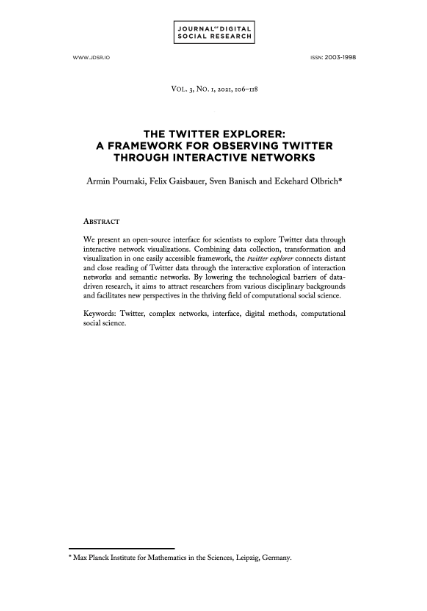The Twitter Explorer: A Framework for Observing Twitter through Interactive Networks
DOI:
https://doi.org/10.33621/jdsr.v3i1.64Keywords:
interface, twitter, complex networks, digital methods, computational social scienceAbstract
We present an open-source interface for scientists to explore Twitter data through interactive network visualizations. Combining data collection, transformation and visualization in one easily accessible framework, the twitter explorer connects distant and close reading of Twitter data through the interactive exploration of interaction networks and semantic networks. By lowering the technological barriers of data-driven research, it aims to attract researchers from various disciplinary backgrounds and facilitates new perspectives in the thriving field of computational social science.
References
Asturiano, Vasco (2018). force-graph. https://github.com/vasturiano/force-graph. [Online; accessed 29-January-2021].
Bastian, Mathieu, Sebastien Heymann, and Mathieu Jacomy (2009). “Gephi: An Open Source Software for Exploring and Manipulating Networks”. In: url: http://www.aaai.org/ocs/index.php/ICWSM/09/paper/view/154.
Black, Alan et al. (2012). “Twitter zombie: Architecture for capturing, socially transforming and analyzing the Twittersphere”. In: Proceedings of the 17th ACM international conference on Supporting group work, pp. 229–238.
Blondel, Vincent D et al. (2008). “Fast unfolding of communities in large networks”. In: Journal of statistical mechanics: theory and experiment 2008.10, P10008.
Borra, Erik and Bernhard Rieder (2014). “Programmed method: Developing a toolset for capturing and analyzing tweets”. In: Aslib Journal of Information Management.
Bostock, Mike (2011). D3.js. https://d3js.org/. [Online; accessed 29-January-2021].
Bruns, Axel and Jean Burgess (2014). “Crisis communication in natural disasters: The Queensland floods and Christchurch earthquakes”. In: Twitter and society [Digital Formations, Volume 89]: ed. by A Bruns et al. United States of America: Peter Lang Publishing, pp. 373–384.
Burgess, Jean and Ariadna Matamoros-Fernández (2016). “Mapping sociocultural controversies across digital media platforms: One week of# gamergate on Twitter, YouTube, and Tumblr”. In: Communication Research and Practice 2.1, pp. 79–96.
Conover, Michael D, Bruno Gonçalves, et al. (Oct. 2011). “Predicting the Political Alignment of Twitter Users”. In: 2011 IEEE Third International Conference on Privacy, Security, Risk and Trust and 2011 IEEE Third International Conference on Social Computing, pp. 192–199. doi: 10.1109/PASSAT/SocialCom.2011.34. Conover, Michael D, Jacob Ratkiewicz, et al. (2011). “Political polarization on twitter”. In: Fifth international AAAI conference on weblogs and social media. Csardi, Gabor and Tamas Nepusz (2006). “The igraph software package for complex network research”. In: InterJournal Complex Systems, p. 1695. url: http://igraph.org.
Davis, Clayton A et al. (2016). “OSoMe: the IUNI observatory on social media”. In: PeerJ Computer Science 2, e87. DocNow (2020). twarc. https://github.com/DocNow/twarc. [Online; accessed 29-January-2021].
Free Software Foundation Inc. (2007). GNU General Public License. https://www.gnu.org/licenses/gpl-3.0.html. [Online; accessed 29-January-2021]. Gaisbauer, Felix et al. (2020). “How Twitter affects the perception of public opinion: Two case studies”. In: arXiv preprint arXiv:2009.01666.
Gaumont, Noé, Maziyar Panahi, and David Chavalarias (Sept. 2018). “Reconstruction of the socio-semantic dynamics of political activist Twitter networks—Method and application to the 2017 French presidential election”. In: PLOS ONE 13.9, pp. 1–38. doi: 10.1371/journal.pone.0201879. url: https://doi.org/10.1371/journal.pone.0201879.
Jänicke, Stefan et al. (2015). “On Close and Distant Reading in Digital Humanities: A Survey and Future Challenges.” In: EuroVis (STARs), pp. 83–103. Jünger, Jakob and Till Keyling (2019). Facepager. https://github.com/strohne/Facepager. [Online; accessed 29-January-2021].
Leal, Wilmer et al. (2018). “Forman-Ricci Curvature for Hypergraphs”. en. In: doi: 10.13140/RG.2.2.27347.84001. url: http://rgdoi.net/10.13140/RG.2.2.27347.84001.
Moretti, Franco (2000). “Conjectures on world literature”. In: New left review 1, p. 54.
Myers, Seth A et al. (2014). “Information network or social network? The structure of the Twitter follow graph”. In: Proceedings of the 23rd International Conference on World Wide Web, pp. 493–498.
Nitins, Tanya and Jean Burgess (2014). “Twitter, brands, and user engagement”. In: Twitter and society [Digital Formations, Volume 89]: ed. by A Bruns et al.
United States of America: Peter Lang Publishing, pp. 293–304.
Noack, Andreas (Feb. 2009). “Modularity clustering is force-directed layout”. In: Physical Review E 79.2, p. 026102. doi: 10.1103/physreve.79.026102.
Paltoglou, Georgios and Mike Thelwall (2017). “Sensing social media: A range of approaches for sentiment analysis”. In: Cyberemotions. Springer, pp. 97–117.
Peixoto, Tiago P. (2014). “The graph-tool python library”. In: figshare. doi: 10.6084/m9.figshare.1164194. url: http://figshare.com/articles/graph_tool/ 1164194 (visited on 09/10/2014).
Pournaki, Armin (2020). twitter-explorer. https://github.com/pournaki/twitter-explorer. [Online; accessed 29-January-2021]. Rainie, Lee (2014). “The six types of Twitter conversations”. In: Pew Research Center 20.
Rosvall, Martin and Carl T Bergstrom (2007). “Maps of information flow reveal community structure in complex networks”. In: arXiv preprint physics.soc- ph/0707.0609.

Downloads
Published
Issue
Section
License
Copyright (c) 2021 The Authors

This work is licensed under a Creative Commons Attribution-ShareAlike 4.0 International License.





